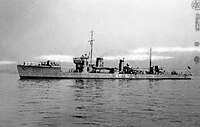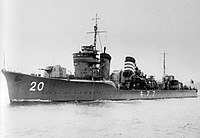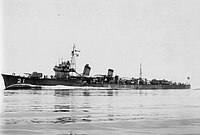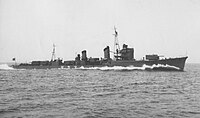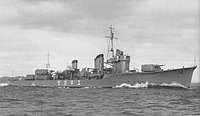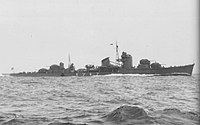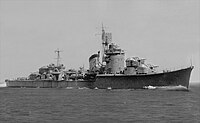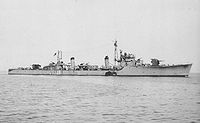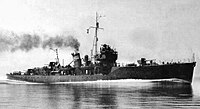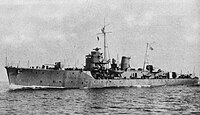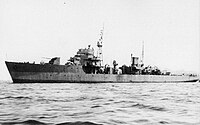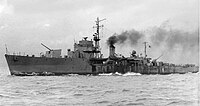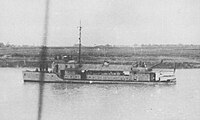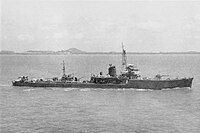This List of Japanese Naval ships and war vessels in World War II is a list of seafaring vessels of the Imperial Japanese Navy of World War II. It includes submarines, battleships, oilers, minelayers and other types of Japanese sea vessels of war and naval ships used during wartime.
Aircraft carrier
Heavy/Fleet carriers
| Fleet Carrier (11) | |||||
|---|---|---|---|---|---|
| Class | Picture | Type | Ships (Years in Service) | Displacement | Note |
| Akagi-class |

|
Fleet carrier | Akagi (1927–1942) | 36,500 tonnes | Converted from an Amagi-class battlecruiser. Sunk at Midway on June 5, 1942 |
| Kaga-class |
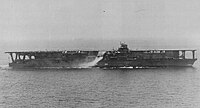
|
Aircraft carrier | Kaga (1928–1942) | 38,200 tonnes | Converted from a Tosa-class battleship. Sunk at Midway on June 4, 1942 |
| Sōryū-class |

|
Aircraft carrier |
Sōryū (1937–1942) Hiryū (1939–1942) |
16,200 tonnes | Hiryū is often considered to be a separated class. Sunk at Midway on June 5, 1942,
Soryu took part in the attack on Pearl Harbor, the Battle of Wake Island, and supported the conquest of the Dutch East Indies. She was sunk at Midway on June 4, 1942 |
| Shōkaku-class |

|
Aircraft carrier |
Shōkaku (1941–1944) Zuikaku (1941–1944) |
25,675 tonnes | With the exception of the Battle of Midway, Shōkaku and Zuikaku participated in every major naval action of the Pacific War, including the attack on Pearl Harbor, the Indian Ocean Raid, the Battle of the Coral Sea, and the Guadalcanal Campaign. Both carriers were sunk during the 1944 Pacific campaigns. |
| Unryū-class |

|
Aircraft carrier |
Unryū (1944–1944) Amagi (1944–1945) Katsuragi (1944–1945) |
17,480 tonnes | The design for these ships was based on the aircraft carrier Hiryū. IJN Planned to build 16 ships, however only 3 were completed and 2 almost completed (one of which was sunk as a target then salvaged and later scrapped) before the project was abandoned in favour of Shinano's construction. Unryū was sunk by the USS Redfish, Amagi capsized after air attacks and Katsuragi was the only heavy carrier to survive the war |
| Taihō-class |

|
Aircraft carrier | Taihō (1944–1944) | 30,250 tonnes | A bit of a break from traditional Japanese carrier design, Taiho was a heavily armoured carrier expected to withstand multiple bombs and torpedo strikes. However, design faults and poor damage control allowed it to be sunk with one torpedo from the USS Albacore on June 19, 1944 |
| Shinano-class |

|
Aircraft carrier | Shinano (1944–1944) | 65,800 tonnes | Initially laid down as the third of the Yamato-class battleships, Shinano was converted into an aircraft carrier due to the Japanese defeat at Midway. She was sunk on November 29, 1944, by torpedoes from USS Archerfish. |
Light carriers
| Light Aircraft Carrier (9) | |||||
|---|---|---|---|---|---|
| Class | Picture | Type | Ships | Displacement | Note |
| Hōshō-class |

|
Light aircraft carrier | Hōshō (1922–1945) | 7,470 tonnes | First purpose-built carrier in the world. Scrapped 1946. |
| Ryūjō-class |

|
Light aircraft carrier | Ryūjō (1931–1942) | 8,000 tonnes | Sunk 1942. |
| Hiyō-class |

|
Light aircraft carrier |
Hiyō (1942–1944) Jun'yō (1942–1946) |
24,150 tonnes | Converted from an ocean liner in 1939. Hiyō sunk and Jun'yō scrapped 1946–1947. |
| Zuihō-class |

|
Light aircraft carrier |
Zuihō (1940–1944) Shōhō (1939–1942) |
11,443 tonnes | Both sunk during WWII. |
| Chitose-class |

|
Light aircraft carrier |
Chitose (1938/1944–1944) Chiyoda (1938/1944–1944) |
11,200 tonnes | Both ships were seaplane tenders before their conversion in 1943. Both ships sunk in 1944. |
| Ryūhō-class |

|
Light aircraft carrier | Ryūhō (1934/1942–1945) | 16,700 tonnes | Converted from the submarine tender Taigei 1941–1942. Recommissioned as Ryūhō 1942. Scrapped 1946. |
Escort carriers
| Escort Carrier (10) | |||||
|---|---|---|---|---|---|
| Class | Picture | Type | Ships | Displacement | Note |
| Taiyō-class |

|
Escort carrier |
Taiyō (1941–44) Chūyō (1942–43) Unyō (1942–44) |
17,830 tonnes | All sunk. |
| Kaiyō-class |

|
Escort carrier | Kaiyō (1943–1945) | 13,600 tonnes. Converted from ocean liner Argentina Maru. | Scrapped 1946. |
| Shin'yō-class |

|
Escort carrier | Shin'yō (1943–1944) | 17,500 tonnes | |
| Akitsu Maru-class |

|
Escort carrier |
Akitsu Maru (1942–1944) Nigitsu Maru (1942–1944) |
11,800 tonnes | Operated by the Imperial Japanese Army. Worlds' first Amphibious Assault ships. |
| Shimane Maru-class |
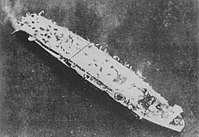
|
Escort carrier | Shimane Maru (1945–1945) | 11,989 tonnes | |
| Yamashio Maru-class |

|
Escort carrier | Yamashio Maru (1945–1945) | 16,119 tonnes | |
| Kumano Maru-class |
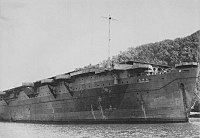
|
Escort carrier | Kumano Maru (1945–1945) | 8,258 tonnes | Operated by Imperial Japanese Army. |
Seaplane tenders
| Seaplane Tender (9) | |||||
|---|---|---|---|---|---|
| Class | Picture | Type | Ships | Displacement | Note |
| Nisshin-class |

|
Seaplane tender | Nisshin (1942–1943) | 11,499 tonnes | Also midget submarine carrier and minelayer |
| Kamikawa Maru-class |

|
Seaplane tender |
Kamikawa Maru (1937–1943) Kiyokawa Maru (1941–1946) Kimikawa Maru (1937–1944) Kunikawa Maru (1937–1945) |
6,862 tonnes | Hirokawa Maru of the same class was converted to auxiliary (anti-aircraft) cruiser instead of seaplane tender when impressed for Navy service |
| Akitsushima-class |

|
Seaplane tender | Akitsushima (1942–1944) | 4,725 tonnes | |
| Kamoi-class |

|
Seaplane tender | Kamoi (1922–1947) | 17,273 tonnes | |
| Notoro-class |

|
Seaplane tender | Notoro (1934–1947) | 15,647 tonnes | Of 7 oilers in class, Notoro was converted to seaplane tender and Shiretoko to munition ship |
| Mizuho-class |

|
Seaplane tender | Mizuho (1939–1942) | 10,930 tonnes | Also midget submarine carrier |
Armoured vessels
Battlecruisers
| Fast Battleship (4) - former battlecruisers | ||||||
|---|---|---|---|---|---|---|
| Class | Picture | Type | Ships in class | Displacement | Main battery | Note |
| Kongō-class |
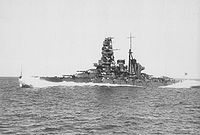
|
Fast battleship |
Kongō (1913–1944) Hiei (1914–1942) Kirishima (1915–1942) Haruna (1915–1945) |
32,156 tonnes | 8 × 14-inch | Laid down and commissioned as Battlecruisers in early 20th century, remodelled into Battleships because of Washington Naval Treaty in the late 20' and into Fast Battleships in 1935, allowing them to accompany growing carrier force. All four were sunk during the war |
Battleships
| Battleship (8) | |||||
|---|---|---|---|---|---|
| Class | Picture | Type | Ships | Displacement | Note |
| Fusō-class |

|
Battleship |
Fusō (1915–1944) Yamashiro (1917–1944) |
29,330 tonnes | There was a plan to convert these ships into Aviation Battleships in 1943. The plan was cancelled and the two Ise-class battleships were converted instead. |
| Ise-class |

|
Battleship |
Ise (1917–1945) Hyūga (1918–1945) |
27,384 tonnes | Converted into Aviation Battleship in 1943. |
| Nagato-class |

|
Battleship |
Nagato (1920–1945) Mutsu (1921–1943) |
32,720 tonnes | Both ships underwent significant modernization on 1934–1936, rebuilding the superstructure into the more familiar pagoda mast style. |
| Yamato-class |

|
Battleship |
Yamato (1941–1945) Musashi (1942–1944) |
69,988 tonnes | 5 planned, 1 converted into an Aircraft carrier, 2 cancelled. Yamato was sunk during a one-way trip to Okinawa during operation Ten-Go. She never saw action there and was sunk by aircraft on the way. |
Heavy cruisers
| Heavy Cruiser (18) | |||||
|---|---|---|---|---|---|
| Class | Picture | Type | Ships | Displacement | Note |
| Furutaka-class |

|
Heavy cruiser |
Furutaka (1926–1942) Kako (1926–1942) |
7,100 tonnes | |
| Aoba-class |
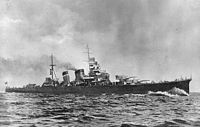
|
Heavy cruiser |
Aoba (1927–1945) Kinugasa (1927–1942) |
7,100 tonnes | Variation of the Furutaka class |
| Myōkō-class |

|
Heavy cruiser |
Myōkō (1929–1945) Nachi (1928–1944) Haguro (1929–1945) Ashigara(1929–1945) |
11,633 tonnes | |
| Takao-class |

|
Heavy cruiser |
Takao Atago Maya Chōkai |
11,633 tonnes | Variation of the Myōkō class |
| Mogami-class |
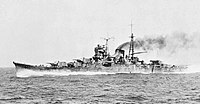
|
Heavy cruiser |
Mogami Mikuma Suzuya Kumano |
8,500 tonnes | Suzuya and Kumano were considered to be a sub-class. Mogami was considered to be an Aviation Cruiser by the IJN (1943). |
| Tone-class |

|
Heavy cruiser |
Tone Chikuma |
11,213 tonnes | Considered as Aviation Cruisers by IJN |
Light cruisers
| Light Cruiser (26) | |||||
|---|---|---|---|---|---|
| Class | Picture | Type | Ships | Displacement | Note |
| Tenryū-class |
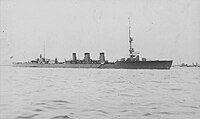
|
Light cruiser |
Tenryū Tatsuta |
3,948 tonnes | |
| Kuma-class |
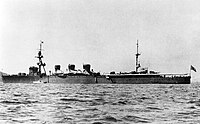
|
Light cruiser |
Kuma Tama Kitakami Ōi Kiso |
5,500 tonnes | Kitakami, Ōi and Kiso later converted to a torpedo cruiser under a short-lived Imperial Japanese Navy program. |
| Nagara-class |

|
Light cruiser |
Nagara Isuzu Yura Natori Kinu Abukuma |
5,570 tonnes | |
| Yūbari-class |
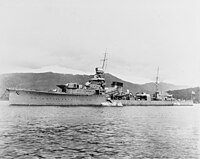
|
Light cruiser | Yūbari | 2,890 t tonnes | An experimental light cruiser. |
| Sendai-class |

|
Light cruiser |
Sendai Jintsu Naka |
5,195 tonnes | 8 planned; 5 cancelled. |
| Katori-class |
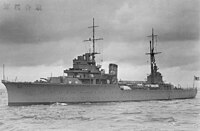
|
Light cruiser |
Katori Kashima Kashii |
5,890 tonnes | 4 planned; 1 cancelled.
Originally served as a training ship. |
| Agano-class |

|
Light cruiser |
Agano Noshiro Yahagi Sakawa |
6,652 tonnes | |
| Ōyodo-class |

|
Light cruiser | Ōyodo | 8,164 tonnes | 2 planned; 1 cancelled. |
| Yasoshima-class |
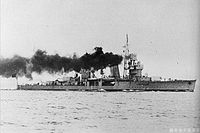
|
Light cruiser |
Yasoshima Ioshima |
2,448 tonnes | Served under the Republic of China Navy under the name of Ping Hai, until seized and re-floated in 1938 by IJN, having been sunk the year before. |
Destroyers
Destroyers
Torpedo boats
| Torpedo Boat (12) | |||||
|---|---|---|---|---|---|
| Class | Picture | Type | Boats | Displacement | Note |
| Chidori-class |
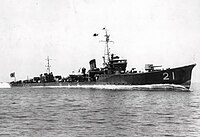
|
Torpedo boat | Chidori | Manazuru | Tomozuru | Hatsukari | 600 tonnes | 20 vessel planned however only 4 completed. 16 replaced by Ōtori-class. |
| Ōtori-class |

|
Torpedo boat | Ōtori | Hiyodori | Hayabusa | Kasasagi | Kiji | Kari | Sagi | Hato | | 960 tonnes | 16 vessel planned however only 8 completed. |
Destroyer escorts (Kaibōkan)
Patrol boats
| Patrol Boat | |||||
|---|---|---|---|---|---|
| Class | Picture | Type | Boats | Displacement | Note |
| No.1-class auxiliary patrol boat |

|
Patrol boat | PBa-1 | PBa-2 | PBa-3 | PBa-25 | PBa-26 | PBa-31 | PBa-37 | PBa-51 | PBa-84 | PBa-90 | PBa-134 | PBa-135 | PBa-136 | PBa-137 | PBa-138 | PBa-152 | PBa-153 | PBa-163 | PBa-164 | PBa-165 | PBa-166 | PBa-173 | PBa-174 | PBa-175 | PBa-179 | PBa-191 | PBa-192 | 238 tons | 280 planned, 27 completed |
Submarine chasers
Submarine
| Submarine (213) | |||||
|---|---|---|---|---|---|
| Class | Picture | Type | Boats | Displacement | Note |
| I-1-class |

|
Submarine | I-1 | I-2 | I-3 | I-4 | I-5 | I-6 | I-7 | I-8 | 1,970 tonnes | The official designation of the submarine was Junsen-type submarine |
| I-9-class |

|
Submarine | I-9 | I-10 | I-11 | I-12 | I-13 | I-14 | 2,434 tonnes | The official designation of the submarine was Type A (Ko) submarine. |
| I-15-class |

|
Submarine | I-15 | I-17 | I-19 | I-21 | I-23 | I-25 | I-26 | I-27 | I-29 | I-30 | I-31 | I-32 | I-33 | I-34 | I-35 | I-36 | I-37 | I-38 | I-39 | I-40 | I-41 | I-42 | I-43 | I-44 | I-45 | I-54 | I-56 | I-58 | 2,184 tonnes | The official designation of the submarine was Type B (Otsu) submarine. |
| I-16-class |

|
Submarine | I-16 | I-18 | I-20 | I-22 | I-24 | I-46 | I-47 | I-48 | I-52 | I-53 | I-55 | 2,184 tonnes | The official designation of the submarine was Type C (Hei) submarine. |
| I-361-class |
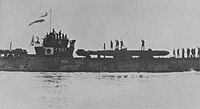
|
Submarine | I-361 | I-362 | I-363 | I-364 | I-365 | I-366 | I-367 | I-368 | I-369 | I-370 | I-371 | I-372 | I-373 | 1,440 tonnes | The official designation of the submarine was Type D (Tei) submarine |
| I-51-class |

|
Submarine | I-51 | I-152 | I-153 | I-154 | I-155 | I-156 | I-157 | I-158 | I-159 | I-60 | I-63 | I-61 | I-162 | I-164 | I-165 | I-66 | I-67 | I-168 | I-169 | I-70 | I-171 | I-73 | I-174 | I-175 | I-176 | I-177 | I-178 | I-179 | I-180 | I-181 | I-182 | I-183 | I-184 | I-185 | 1,575 tonnes | The official designation of the submarine was Kaidai-type submarine |
| I-121-class |

|
Submarine | I-121 | I-122 | I-123 | I-124 | 1,142 tonnes | The official designation of the submarine was Kiraisen-type submarine |
| I-351-class |

|
Submarine | I-351 | 3,512 tonnes | Planned 6. Completed 1. The official designation of the submarine was Senho-type submarine |
| I-201-class |

|
Submarine |
I-201 I-202 I-203 |
1,503 tonnes | The official designation of the submarine was Sentaka-type submarine |
| I-501-class | Submarine | I-501 | 1,616 tonnes | Was German Kriegsmarine submarine under the name U-181, until given to Japan May 1945. | |
| I-502-class | Submarine | I-502 | 1,610 tonnes | Was German Kriegsmarine submarine under the name U-862, until given to Japan May 1945. | |
| I-503-class |
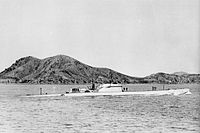
|
Submarine | I-503 | 1,610 tonnes | Was a Regia Marina submarine under the name Comandante Cappelini then captured by IJN after Italy's capitulation then given to Kriegsmarine in September 1943 under the name UIT-24. After that captured again by IJN in May 1945 after Nazi-Germany's surrender. |
| I-504-class | Submarine | I-504 | 1,763 tonnes | Was Regia Marina submarine under the name Luigi Torelli then it was temporarily interned to IJN after Italy's capitulation then given to Kriegsmarine in September 1943 under the name UIT-25. After that captured again by IJN in May 1945 after Nazi-Germany's surrender. | |
| I-505-class | Submarine | I-505 | 1,763 tonnes | Was German Kriegsmarine submarine under the name U-219, until given to Japan May 1945. | |
| I-506-class | Submarine | I-506 | 1,610 tonnes | Was German Kriegsmarine submarine under the name U-195, until given to Japan May 1945. | |
| Ro-11-class |

|
Submarine | Ro-11 | Ro-12 | Ro-13 | Ro-14 | Ro-15 | Ro-16 | Ro-17 | Ro-18 | Ro-19 | Ro-20 | Ro-21 | Ro-22 | Ro-23 | Ro-24 | Ro-25 | Ro-26 | Ro-27 | Ro-28 | Ro-29 | Ro-30 | Ro-31 | Ro-32 | Ro-33 | Ro-34 | Ro-35 | Ro-36 | Ro-37 | Ro-37 | Ro-38 | Ro-39 | Ro-40 | Ro-41 | Ro-42 | Ro-43 | Ro-44 | Ro-45 | Ro-46 | Ro-47 | Ro-48 | Ro-49 | Ro-50 | Ro-55 | Ro-56 | 720 tonnes | The official designation of the submarine was Type Kaichū submarine. |
| Ro-51-class |

|
Submarine | Ro-51 | Ro-52 | Ro-53 | Ro-54 | Ro-55 | Ro-56 | Ro-57 | Ro-58 | Ro-59 | Ro-60 | Ro-61 | Ro-62 | Ro-63 | Ro-64 | Ro-65 | Ro-66 | Ro-67 | Ro-68 | 893 tonnes | The official designation of the submarine was Type L submarine |
| Ro-100-class |

|
Submarine | Ro-100 | Ro-101 | Ro-102 | Ro-103 | Ro-104 | Ro-105 | Ro-106 | Ro-107 | Ro-108 | Ro-109 | Ro-110 | Ro-111 | Ro-112 | Ro-113 | Ro-114 | Ro-115 | Ro-116 | Ro-117 | 525 tonnes | |
| Ha-201-class |

|
Submarine | Ha-201 | Ha-202 | Ha-203 | Ha-204 | Ha-205 | Ha-207 | Ha-208 | Ha-209 | Ha-210 | Ha-216 | 320 tonnes | Never saw combat The official designation of the submarine was Sentaka-Shō type submarine. |
| Ro-500-class |

|
Submarine | Ro-500 | 1,120 tonnes | Was German Kriegsmarine submarine under the name U-511, until given to Japan 16 September 1943. |
| Ro-501-class | Submarine | Ro-501 | 1,144 tonnes | Was German Kriegsmarine submarine under the name U-1224, until given to Japan 15 February 1944. | |
| Submarine aircraft carrier (3) | |||||
|---|---|---|---|---|---|
| Class | Picture | Type | Boats | Displacement | Note |
| I-400-class |

|
Submarine aircraft carrier |
I-400 I-401 I-402 |
6,560 tonnes | The official designation of the submarine was Sentoku type Submarine. |
| Transport Submarine (49) | |||||
|---|---|---|---|---|---|
| Class | Picture | Type | Boats | Displacement | Note |
| Ha-101-class |

|
Transport submarine | Ha-101 | Ha-102 | Ha-103 | Ha-104 | Ha-105 | Ha-106 | Ha-107 | Ha-108 | Ha-109 | Ha-111 | 370 tonnes | The official designation of the submarine was Sen'yu type submarine |
| Yu-class |

|
Transport submarine | Yu-1 | Yu-2 | Yu-3 | Yu-4 | Yu-5 | Yu-6 | Yu-7 | Yu-8 | Yu-9 | Yu-10 | Yu-11 | Yu-12 | Yu-13 | Yu-14 | Yu-15 | Yu-16 | Yu-17 | Yu-18 | Yu-19 | Yu-20 | Yu-21 | Yu-22 | Yu-23 | Yu-24 | Yu-1001 | Yu-1002 | Yu-1003 | Yu-1005 | Yu-1006 | Yu-1007 | Yu-1008 | Yu-1009 | Yu-1010 | Yu-2001 | Yu-2002 | Yu-3001 | Yu-3002 | Yu-3003 | 274 tonnes | Used by Imperial Japanese Army. |
Submarine tender
| Submarine Tender (3) | |||||
|---|---|---|---|---|---|
| Class | Picture | Type | Ships | Displacement | Note |
| Jingei-class |
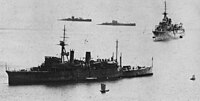
|
Submarine tender |
Jingei Chōgei |
6,240 tonnes | |
| Taigei-class |

|
Submarine tender | Taigei | 16,700 tonnes | Converted into Light aircraft carrier. |
Gunboats
Mine warfare vessels
Auxiliary vessels
Food Supply Ship
| Food Supply Ship (8) | |||||
|---|---|---|---|---|---|
| Class | Picture | Type | Ships | Displacement | Note |
| Mamiya-class |

|
Food supply ship | Mamiya | 15,820 tonnes | |
| Ekkai-class | Food supply ship | Ekkai Maru | 2,984 tonnes | Originally belonging to Honduras, he was captured in Shanghai the same day the country declared war on Japan. | |
| Nosaki-class |

|
Food supply ship | Nosaki | 650 tonnes | |
| Kinesaki-class |

|
Food supply ship |
Kinesaki Hayasaki Shirasaki Arasaki |
910 tonnes | |
| Irako-class |

|
Food supply ship | Irako | 9,570 tonnes | |
| Kurasaki-class | Food supply ship | Kurasaki | |||
| Muroto-class | Food supply ship | Muroto | 8,125 tonnes | ||
| Kitakami-Maru-class | Food supply ship | Kitakami-Maru | 498 tonnes | ||
Repair ship
| Repair Ship (2) | |||||
|---|---|---|---|---|---|
| Class | Picture | Type | Ships | Displacement | Note |
| Asahi-class |
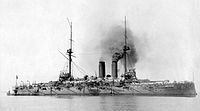
|
Repair ship | Asahi | 15,200 tonnes | Converted from Pre-dreadnought battleship. |
| Akashi-class |

|
Repair ship | Akashi | 9,000 tonnes | |
Survey ship
| Survey Ships (1) | |||||
|---|---|---|---|---|---|
| Class | Picture | Type | Ships | Displacement | Note |
| Tsukushi-class |

|
Survey ship | Tsukushi | 1,422 tonnes | Planned 2. Cancelled 1. |


